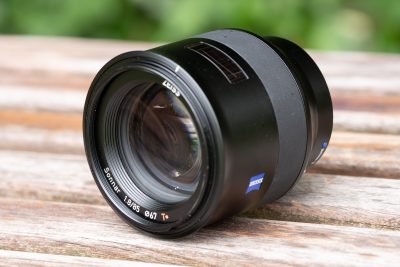Zeiss Batis 85mm f1.8 review
-
-
Written by Thomas
In depth
The Zeiss 85mm f1.8 Batis is a short-telephoto prime lens for Sony’s mirrorless cameras, and corrected for use on full-frame bodies. The 85mm focal length is a classic for portrait shooters, but also useful for street photography or picking-out details in urban or natural landscapes. Launched in 2015, the 85mm f1.8 Batis is positioned between Sony’s flagship FE 85mm f1.4 G Master and the Sony FE 85mm f1.8. It also features a unique OLED display, indicating the focusing distance and depth-of-field range at a glance.
To find out how the Zeiss 85mm f1.8 Batis performs I tested it on the 42MP A7R II body against the Sony FE 85mm f1.8. So if you’re interested in which short-telephoto prime to choose, you’ve come to the right place!
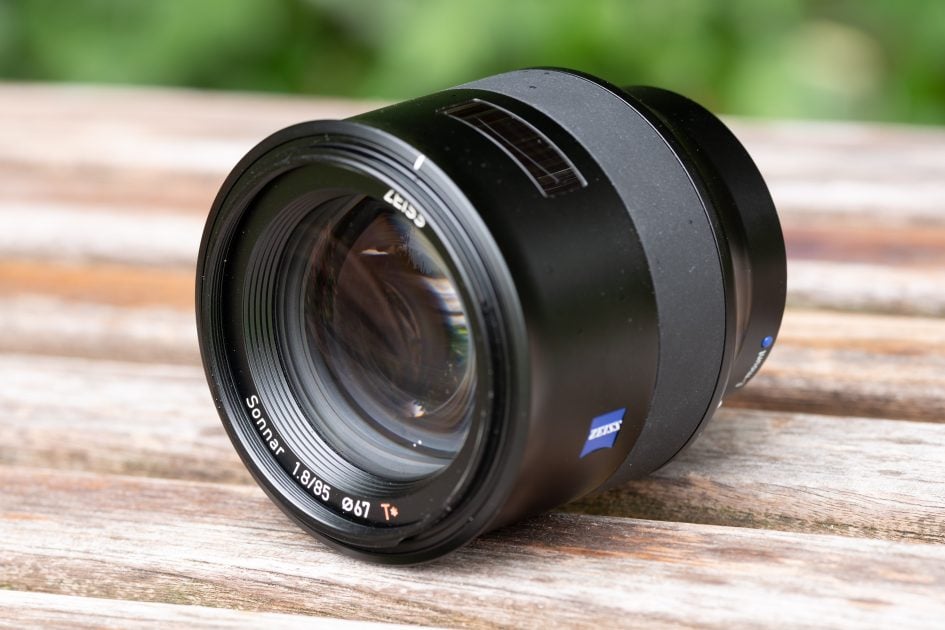
Facts from the catalog
As usual I’ll have a look at the technical data of the Zeiss 85mm f1.8 Batis first. I’ve rated the features with a [+] (or [++]), when it’s better than average or even state of the art, a [0] if it’s standard or just average, and [-] if there’s a disadvantage. For comparison I use the Sony FE 85mm f1.8 (“Sony” for short).
Size (diameter x length): 78 x 86mm (3.1 x 3.4in.) plus 48mm for the lens hood which is 93mm in diameter. The Sony is slightly shorter at 78 x 82mm + 36mm for the lens hood (86mm diameter). [+]
Weight: 453g (16.0 oz.) plus 37g for the lens hood. The Sony is 374g (13.2 oz.) plus 28g for the lens hood. [0]
Optics: 11 elements (including 3 special dispersion elements) in 8 groups. The Sony has the same number of glass/air surfaces: 9 elements in 8 groups. [+]
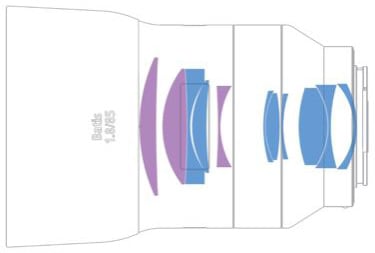
Closest focus distance is 0.80m (31in.) with a magnification of 1:7.6 which is not much. 1:10 magnification is achieved at 1.01m distance. The Sony achieves a similar magnification. [0]
Filter-thread: 67mm, the same as the Sony. [+]
Image stabilization: The Batis has its own optical image stabilization. The Sony lens has to rely on the built-in sensor-shift stabilization of more recent Sony A7 bodies. [+]
Auto focus: Yes with built-in AF drive. Manual-focus override is by simply turning the focus ring. The focus ring has a variable gearing that allows for very precise manual focus when turned slowly. Unfortunately this feature cannot be switched to linear gearing which makes smooth focus pulling for videographers almost impossible. The lens has a display for focus distance and depth of field. [+]
Covers full frame/FX or smaller. Same with the competition. [+]
Price: The lens currently sells for 1150 EUR (incl. 19% VAT) / 1200 USD. The Sony goes for 600 EUR / 600 USD. [0]
Comes with no pouch but the lens hood is included, reversible for transport. Same with the Sony. [0]
Aperture ring: no, just like the Sony. [0]
Sealing: yes, a rubber grommet at the lens-mount plus further special weather-sealing throughout the construction, just like the Sony. [+]
Display: The Batis lenses uniquely feature a small OLED display which indicates the focusing distance, as well as the minimum and maximum distances covered by the depth-of-field at the current aperture. This is a useful solution for modern mirrorless lenses with motorised fly-by-wire focusing, as they often lack the focus distance and depth-of-field markings of more traditional lenses. The Batis solution is also superior at larger apertures where the depth-of-field is so narrow it can’t be accurately indicated by a traditional printed scale. So while at first the display may seem like a novelty, it can be genuinely useful, especially for indicating the range of focus at a glance. Knowing the depth-of-field is, say, only 10cm, may immediately prompt you into adjusting the aperture. [+]
The score in the “features-department” is 0[-]/5[0]/8[+], the most prominent features of the lens being its built-in image stabilization and the display for distance and depth-of-field. It’s also relatively small, well protected against the elements, and has very nice build quality.
Two Sony and two Zeiss 85mm prime lenses
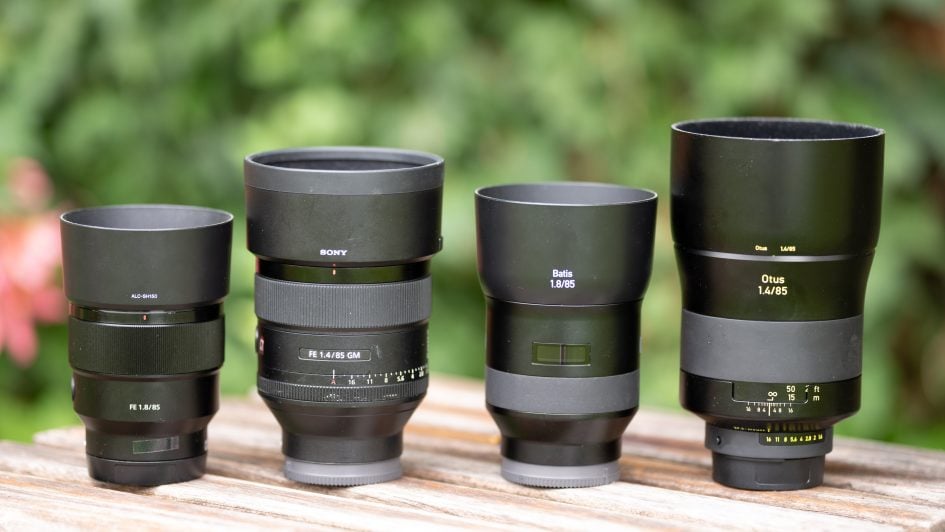
Above from left to right: Sony FE 85mm f1.8, Sony FE 85mm f1.4 GM, Zeiss 85mm f1.8 Batis, Zeiss 85mm f1.4 Otus (needs E-mount adapter)
Alternatives
If you want a large aperture 85mm lens with E-mount and autofocus there are just 3 alternatives, two of them are larger and heavier f1.4 lenses:
- Sony has the FE 85mm f1.8 from 2017 for 600 EUR / 600 USD. For more information see my Sony 85mm f1.8 review. And there is the FE 85mm f1.4 GM from 2016 which sells for 1680 EUR / 1800 USD (see my Sony FE 85mm f1.4 GM sample images).
- Sigma offers the AF 85mm 1.4 DG HSM Art (1120 EUR / 1200 USD). It’s an optical design from 2016 which is available in E-mount since 2018. Interestingly it’s priced the same as the Zeiss Batis which has a 2/3 of a stop slower focal ratio. See my Sigma 85mm f1.4 Art review where it earned a Highly Recommended.
If you consider adapted or manual focus lenses, there are other alternatives:
- Tamron has the SP AF 85mm f1.8 Di USD for A-mount costing about 640 EUR / 750 USD (+ 125 EUR / 200 USD for the Sony LA-EA3 mount adapter). It came Highly Recommended in my Tamron SP 85mm f1.8 VC review where I had a look at the stabilized version for Nikon F-mount which is optically the same.
- Samyang/Rokinon/Walimex has a whole slew of 85mm lenses but only one offers autofocus: the AF 85mm f1.4 EF, which is only available in Canon EF-mount and costs around 540 EUR / 680 USD. Add to that the costs of an EF to E mount converter like the Sigma MC-11 (250 EUR / 150 USD). Or you get the manual focus 85mm f1.4 AS IF UMC which is available in E-mount (320 EUR / 250 USD).
Focus
Focus accuracy and repeatability is critical to consistently produce sharp shots especially with large aperture lenses. Repeatability (the accuracy of focus on the same subject after repeated focus-acquisition) of this lens is relatively good (measured 95.5% in Reikan FoCal) with only 3 mildly soft results over a series of 40 shots. There is only little focus variation whether the lens focuses from a closer distance or from infinity.
The lens focuses in around 1 sec on an A7R II from infinity to 1m (1:10 magnification), which is slow. The Sony FE 85mm f1.8 is a little faster at 0.7 seconds. The focus/control ring is 18mm wide. It moves super smooth and can easily be operated with one finger.
AF-operation of the Zeiss Batis is barely audible from the outside and if you record video with the built-in microphone the AF-drive produces no sound. As you pull focus, you’ll notice a some focus breathing: the image becomes more magnified at closer focusing distances. When I adjusted the focus from infinity to 1m, I measured a 13% increase in magnification. This is very visible and pretty distracting when shooting videos. The Sony is the same.
Image stabilization
To test the effectiveness of the image stabilization with the Zeiss 85mm f1.8 Batis on a A7R II body, I did a series of 140 test-shots hand-held. I tested with shutter speeds from 1/100 of a second down to 0.3 sec. Shots at 1/100 sec with steady shot=OFF are used as reference of how good my hand-holding was at the time of the test and Reikan FoCal did the chore of evaluating the sharpness of all shots. Here’re the details: With steady shot=ON the combo produced 80% sharp shots at 1/25 sec (2 stops) which went down to 70% at 1/13 sec (3 stops). At 1/6 sec only 20% of the shots were usable. This is a 2-3 stop advantage over my unstabilised results, but it’s actually a little worse than I measured for the Sony FE 85mm f1.8 when exclusively using the stabilization built into the A7R II body. So while the optical stabilisation may be beneficial to Mark I A7 bodies which didn’t have sensor-shift stabilisation, owners of Mark II or later bodies may actually get better compensation from unstabilised lenses which are forced to use the full body-based system alone. Of course your mileage may vary.
Next check out my quality results!
Check prices on the Zeiss Batis 85mm f1.8 at Amazon, B&H, or Adorama, or Wex. Alternatively get yourself a copy of my In Camera book or treat me to a coffee! Thanks!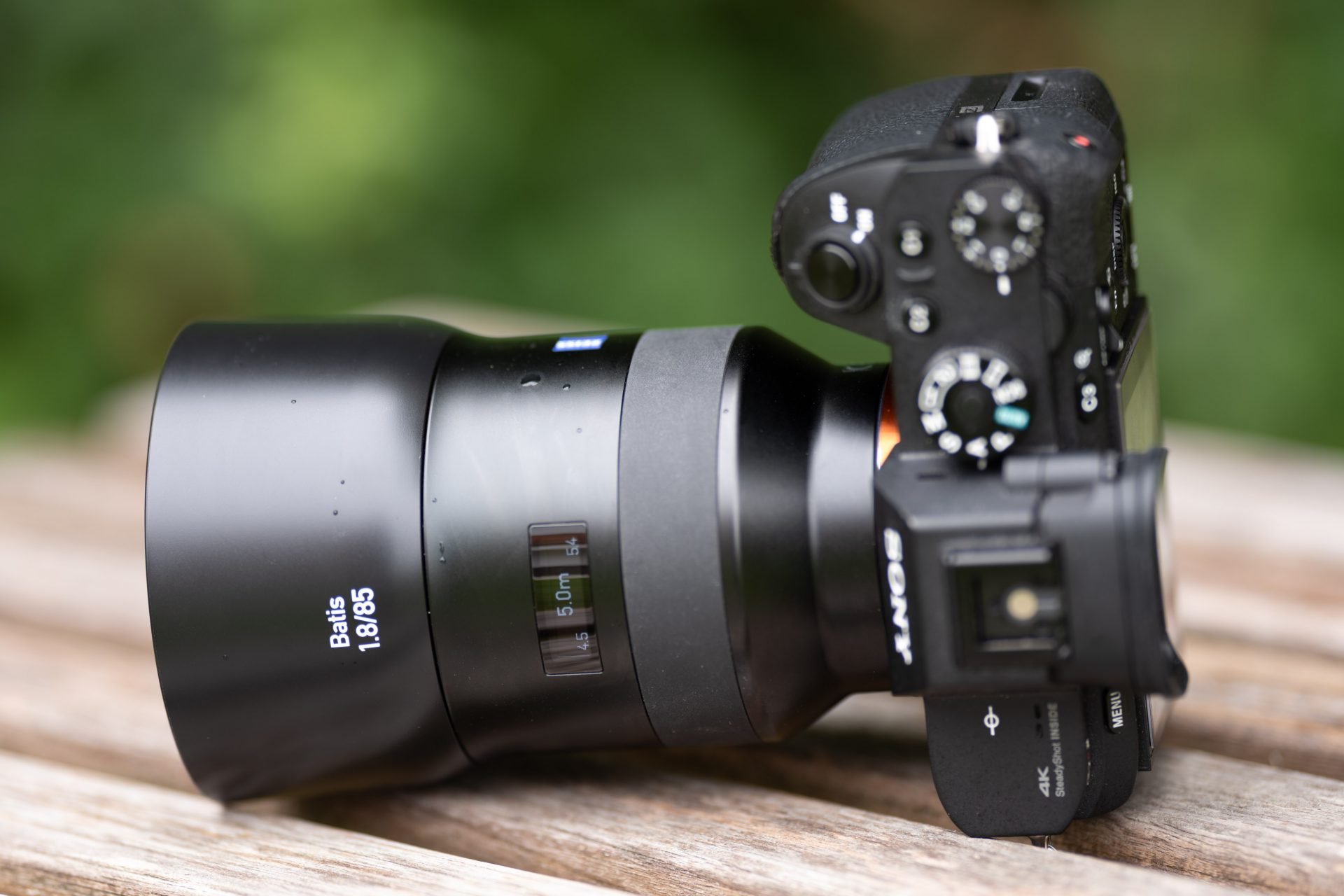
 The Zeiss 85mm f1.8 Batis is short-telephoto lens for Sony's e-mount mirrorless cameras, and a clear step-up in image quality over Sony's own FE 85mm f1.8 lens: it's sharper in the important areas, has less longitudinal CAs, less haloing around bright light sources, and better resistance against flare and glare in strong contra light. It also has superior build quality plus a useful display to indicate distance and depth-of-field. The presence of optical stabilisation is desirable for owners of Mark I A7 bodies, although gives it no advantage over unstabilised lenses mounted on more recent bodies with SteadyShot inside; indeed the combination of optical and sensor-shift stabilisation actually proved less effective than body-based stabilisation alone in my tests. The Zeiss Batis is also slower to focus and has worse vignetting than the native Sony lenses. Its biggest distractor though is its price which is double that of Sony's own FE 85mm f1.8 and equal to the very good Sigma 85mm f1.4 Art. That said, it's still cheaper than Sony's flagship 85mm G Master and its overall optical qualities earn it a Recommended.
The Zeiss 85mm f1.8 Batis is short-telephoto lens for Sony's e-mount mirrorless cameras, and a clear step-up in image quality over Sony's own FE 85mm f1.8 lens: it's sharper in the important areas, has less longitudinal CAs, less haloing around bright light sources, and better resistance against flare and glare in strong contra light. It also has superior build quality plus a useful display to indicate distance and depth-of-field. The presence of optical stabilisation is desirable for owners of Mark I A7 bodies, although gives it no advantage over unstabilised lenses mounted on more recent bodies with SteadyShot inside; indeed the combination of optical and sensor-shift stabilisation actually proved less effective than body-based stabilisation alone in my tests. The Zeiss Batis is also slower to focus and has worse vignetting than the native Sony lenses. Its biggest distractor though is its price which is double that of Sony's own FE 85mm f1.8 and equal to the very good Sigma 85mm f1.4 Art. That said, it's still cheaper than Sony's flagship 85mm G Master and its overall optical qualities earn it a Recommended.



